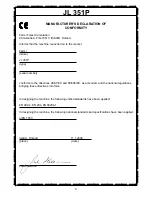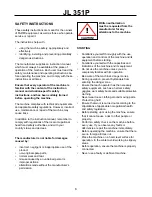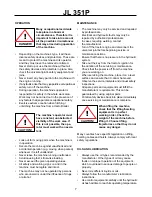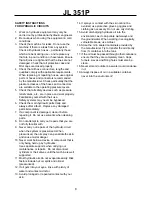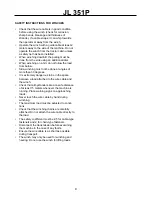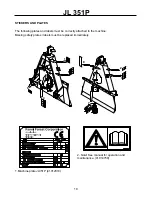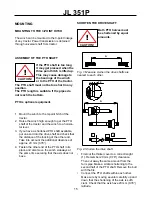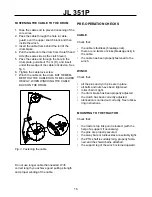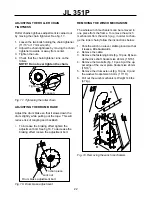
JL 351P
8
SAFETY INSTRUCTIONS
FOR HYDRAULIC CIRCUITS
Work on hydraulic equipment may only be
carried out by professional hydraulic engineers.
Be cautious when using the equipment in cold
conditions.
Check the machine for leaks. Do not use the
machine if there is a leak from any system.
Check all hydraulic hoses – particularly those
which are bent during use – and replace any
that are in poor condition or have leaks. Ensure
that all joins are tight and that the lines are not
damaged. Check that all protective caps and
¿OOHUFDSVDUHFORVHGSURSHUO\
Check that all hose connectors, lengths and
qualities comply with applicable requirements.
When replacing or repairing hoses, use original
parts or hoses and connectors recommended
by the manufacturer. Check particularly that the
pressure classes of the hoses and connectors
are suitable to the operating pressure levels.
Check that all safety devices such as pressure
relief valves, etc., are in place and work properly.
Familiarize yourself with their use.
Safety systems may never be bypassed.
Check the main hydraulic parts daily, and
always after a fault. Replace any damaged
parts immediately.
If a component is damaged, clean it before
repairing it. Do not use solvents when cleaning
parts.
Do not attempt to carry out repairs that you are
not fully familiar with.
Never carry out repairs of the hydraulic circuit
when the system is pressurized. When
pressurized, the oil spray can penetrate the skin
and cause mortal danger.
Never work below a device or component that is
only being held up by hydraulics.
Use separate supports when carrying our
maintenance or repairs. Do not disconnect
cylinders or their valves until the machine is well
supported.
Most hydraulic oils do not evaporate easily. Risk
factors include hot oil, spills and oil mist
(pressurized).
If oil gets into your eyes, rinse with plenty of
water and contact a doctor.
Avoid prolonged or repeated contact with your
skin.
1.
2.
3.
4.
5.
6.
7.
8.
9.
10.
11.
12.
13.
If sprays or contact with the skin cannot be
avoided, use protective gloves, goggles and
clothing as necessary. Do not use oily clothing.
Avoid discharging hydraulic oil into the
environment, as it can pollute waterways and
the groundwater. When working in ecologically
vulnerable areas, use biofuel.
Store the oil in sealed containers provided by
the manufacturer. Try to transfer the oil directly
from its container into the tank.
If the oil must be passed through other containers,
ensure that they are completely clean. Caps,
IXQQHOVVLHYHVDQG¿OOLQJKROHVPXVWDOVREH
clean.
Never store oil outdoors, as water could condense
in it.
Always dispose of oil in a suitable container,
never into the environment!
14.
15.
16.
17.
18.
19.
Summary of Contents for JL 351P
Page 2: ......
Page 25: ...JL 351P 25 ...
Page 34: ...JL 351P 34 LL ASV TP14IH NK45 SV PLL NK1 W2200 HOF 4 ATP JK LK ACCESSORIES ...
Page 36: ...JL 351P 36 ...
Page 39: ......




